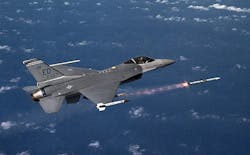Air Force Research Lab asks Leidos to redefine the state of the art in aircraft missile defense
WRIGHT-PATTERSON AFB, Ohio, 24 Sept. 2014.Aerial missile defense experts at Leidos Inc. in Reston, Va., will attempt to advance the state of the art in aircraft missile warning and countermeasures under terms of a $49.4 million U.S. Air Force research contract announced this week.
Officials of the Air Force Research Laboratory at Wright-Patterson Air Force Base, Ohio, are asking Leidos experts to move missile-warning and -countermeasures technologies forward as part of the Air Force Threat Warning Countermeasures (TWCM) program.
The TWCM contract calls for Leidos experts to characterize and assess the vulnerabilities of missiles and sensors; simulate missile-detection sensors and enemy missiles; and evaluate potential advanced air-defense countermeasures.
Leidos researchers will investigate advanced integrated threat warning and countermeasure responses that include missile warning, laser warning, and hostile fire indication, Air Force officials say. The company also will develop ways to detect and counter missile, laser, and hostile fire threats to U.S. military aircraft.
Threats to aircraft continue to evolve, which makes aircraft self-protection increasingly difficult, Air Force researchers explain. Air crews need situational awareness that involves threat warning for missiles, lasers, and hostile fire as well as a means of defeating the threats through countermeasures, officials say.
The TWCM program is asking Leidos to test and evaluate new kinds of integrated threat warning and countermeasures that can include electro-optical, infrared, directional, and proactive countermeasures.
Related: Army ready to move laser-based aircraft missile countermeasures to full-scale development
The goal is for Leidos engineers to integrate a broad spectrum of missile- and laser-warning sensors, mature electro-optical threat warning approaches, and develop cooperative aircraft self-protection techniques.
On this contract Leidos will do the work at Wright-Patterson Air Force Base in Dayton, Ohio, and should be finished by September 2020. For more information contact Leidos online at www.leidos.com, or the Air Force Research Lab at www.wpafb.af.mil/afrl.

